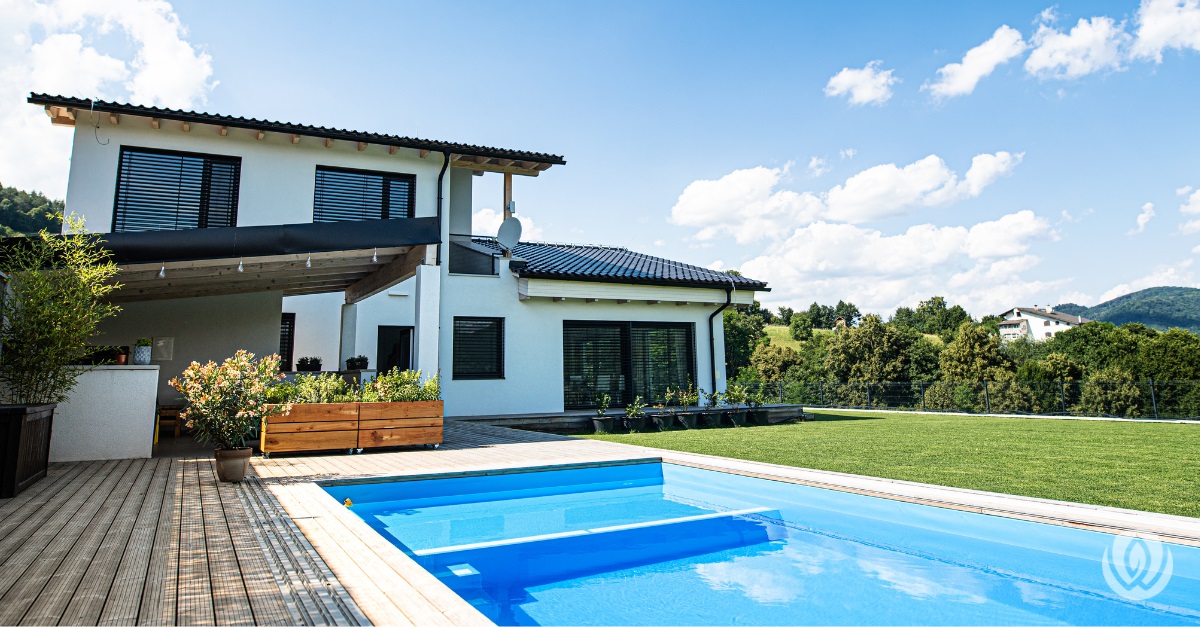Maintenance of a saltwater pool can seem like a daunting task, but with the right guidance and routine practices, it becomes a manageable and rewarding experience.
The benefits of saltwater pools include softer water, reduced chemical use, and a more natural swimming experience. However, to fully enjoy these advantages, it's crucial to understand the specific maintenance needs of a saltwater system.
This blog provides you with essential tips to ensure your saltwater pool remains clean, balanced, and inviting throughout the season. From managing salinity levels to preventing erosion and calcium buildup, we'll cover the key aspects that will help you keep your pool in pristine condition with minimal hassle.
Dive in and discover how a little regular pool maintenance can go a long way in preserving the beauty and functionality of your saltwater oasis.
Benefits of Saltwater Pools
1. Gentle on Skin, Eyes, and Hair
Saltwater pools are known for being kinder to your body. The water feels softer and doesn't cause the red, stinging eyes or dry, tight skin often associated with traditional chlorine pools. You'll enjoy a smoother swim and your swimsuits will retain their colors longer, ensuring a more pleasant and comfortable experience for everyone.
2. Lower Maintenance
One of the standout benefits of saltwater pools is their ease of maintenance. The saltwater system continuously generates the necessary amount of chlorine, keeping the pool clean with minimal manual intervention.
This means you won't have to add chlorine as frequently, saving you time and effort. Plus, the consistent chlorine levels help maintain the water quality more effectively throughout the swimming season.
3. Fewer Chloramines and Reduced Chlorine Smell
Saltwater pools produce fewer chloramines, the compounds responsible for the strong chlorine smell and eye irritation in traditional pools. With fewer chloramines, your pool will smell fresher and be more enjoyable for swimming, making it a great choice for families and anyone sensitive to chlorine.
4. Increased Home Value
Installing a saltwater pool can enhance your home's value. Many prospective buyers view saltwater pools as a desirable feature due to their benefits and lower long-term maintenance costs. This can make your home more appealing in the real estate market.
Disadvantages of Saltwater Pools
1. Higher Upfront Costs
Transitioning to a saltwater pool or installing one from scratch involves significant initial expenses. You'll need specialized equipment, such as a saltwater generator and salt-safe materials for components like ladders and handrails. These costs can add up, making saltwater pools a more substantial initial investment compared to traditional chlorine pools.
2. Corrosive Properties of Salt
Saltwater can be corrosive, potentially damaging metal parts of your pool over time, including ladders, handrails, and even certain types of pool linings. It can also cause staining on nearby patio stones and decks if not properly managed.
To mitigate these issues, it's important to use corrosion-resistant materials and seal any surrounding surfaces to protect them from salt damage.
3. Dependence on Electricity
The chlorine generation process in saltwater pools relies on electricity. During power outages, your pool won't be able to produce chlorine, which could be inconvenient during peak swimming times or in areas prone to frequent outages. It’s essential to plan for these situations to ensure your pool remains safe and clean.
What are Some Saltwater Pool Maintenance Tips I Should Know?
1. Add the Right Amount of Salt to Your Pool
- Frequency: Typically, you only need to add salt when you first set up the pool, after opening it for the season, or following heavy rain or significant water additions which dilute the salt concentration.
- Type of Salt: Use pool-grade salt (sodium chloride) that is at least 99% pure. Avoid using table salt, rock salt, or de-icing salt, which can contain impurities that harm the pool.
- Procedure: Turn off your salt chlorine generator before adding salt to prevent potential damage. Pour the salt into the deep end of the pool and use a pool brush to help it dissolve. Run the pool pump for at least 24 hours to ensure the salt is evenly distributed.
Amount to Add:
- Salinity Levels: Aim for a salinity level between 2,700 and 3,400 parts per million (PPM), with 3,200 PPM being ideal. Check your owner's manual for specific recommendations.
- Calculation: Use a pool salinity calculator to determine the exact amount of salt needed. For example, a 20,000-gallon pool may require about 568 pounds of salt initially.
Testing and Adjusting:
- Testing: After the salt has dissolved, test the water’s salinity using a digital salinity tester or salt test strips. If the salinity is too low, add more salt; if it’s too high, dilute the pool water with fresh water.
2. Maintain Proper Water Circulation
Importance of Circulation:
- Even Distribution: Proper circulation ensures that salt and chlorine are evenly distributed throughout the pool, preventing areas of high concentration that can lead to equipment damage and ineffective sanitation.
Daily and Weekly Practices:
- Pump Operation: Run your pool pump and filter for at least 8 hours a day to maintain good water circulation. Adjust the duration based on pool size and usage.
- Testing Circulation: Test salinity levels in multiple areas of the pool to ensure consistent readings. If there are discrepancies, adjust your return jets to improve circulation in dead zones.
3. Prevent Erosion and Calcium Buildup
Managing Salt Splash:
- Erosion Prevention: Regularly hose down the area around your pool, including decks and coping, to wash away salt deposits. This is particularly important for stone, concrete, and metal surfaces that are vulnerable to salt corrosion.
- Protecting Equipment: Rinse the metal tracks and hardware of automatic pool covers to prevent corrosion. Pay special attention to areas where saltwater can accumulate.
Calcium Buildup:
- Identification: White flakes in your pool are often calcium carbonate deposits, not salt. These are caused by the high pH byproduct from the salt chlorine generator.
- Prevention: Avoid using calcium-based chlorine shocks like cal-hypo shock, which can exacerbate calcium buildup. Regularly clean your salt cell to prevent scale formation.
4. Check Your Salt Cell Every 3 Months
Inspection and Cleaning:
- Frequency: Inspect your salt cell every 3 months for calcium and debris buildup.
- Procedure: Turn off and unplug the salt chlorine generator before removing the salt cell. Inspect the metal plates for white, flaky deposits.
- Cleaning: If deposits are present, clean the cell by rinsing with a hose or using a diluted muriatic acid solution (5:1 water to acid ratio). Handle acid carefully, wearing protective gear. Avoid frequent chemical cleanings to prolong the cell’s life.
Reassembly: After cleaning, reassemble the system and check it again in a few months. Regular maintenance prevents performance issues and extends the cell’s lifespan.
5. Keep Your Water Balanced, Especially pH and Chlorine
Regular Testing and Balancing:
- Free Chlorine Levels: Test the free chlorine levels weekly, aiming for around 3 PPM. Use liquid test kits or test strips to verify the accuracy of your salt chlorine generator’s readings.
- pH Levels: Saltwater pools tend to have higher pH levels. Test and adjust the pH weekly to maintain it between 7.2 and 7.6. Use pH decreaser (muriatic acid) to lower pH levels as needed.
Other Balancing Parameters:
- Alkalinity: Test and adjust alkalinity levels monthly, aiming for 80 to 120 PPM. Alkalinity helps stabilize pH levels.
- Stabilizer (Cyanuric Acid): Maintain stabilizer levels at 70 to 80 PPM to protect chlorine from sunlight degradation.
- Calcium Hardness: Aim for calcium hardness levels between 200 and 400 PPM to prevent scaling and corrosion.
Pro Tips:
- Alerts: Set reminders on your phone or calendar to stay on top of testing and balancing tasks.
- Manual Testing: Even if your salt chlorine generator displays salinity levels, manually test them monthly to ensure accuracy and prevent potential issues.
By following these essential maintenance tips, you can ensure your saltwater pool remains a refreshing and enjoyable retreat throughout the swimming season.
Regularly testing and balancing your water, inspecting your salt cell, and managing proper circulation are key steps to keeping your pool clean and your equipment in top condition.
Remember, a well-maintained saltwater pool not only provides a better swimming experience but also extends the life of your pool system. With a little effort and attention to detail, you can enjoy the many benefits of a saltwater pool with minimal hassle, making every swim a pleasant and relaxing experience.
Build It. Dream It. Live It.
Ready to dive into your own luxury saltwater swimming pool?
LiveWell Outdoors is here to help—no matter the size of your outdoor space.
Don’t risk missing out on the backyard saltwater oasis you’ve always wanted. Schedule a consultation today and take the first step towards creating your luxury experience.





